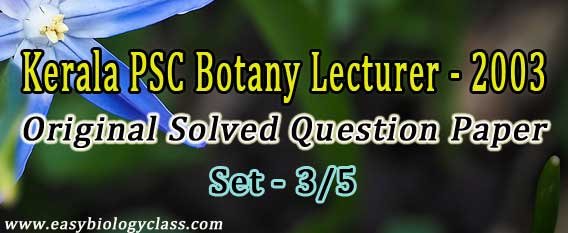
Kerala PSC Botany Lecturer / Assistant Professor Original Solved Question Paper: 2003 Exam
(Question Paper Code: 250/2003)
Original solved question paper of Kerala PSC Botany Lecturer/Assistant Professor examination conducted by Kerala PSC (Kerala Public Service Commission) for the recruitment / appointment of Botany Lecturer/Assistant Professor in Government Colleges of Kerala under the Directorate of Collegiate Education, Trivandrum, Kerala. The test was conducted in the year 2003 and the Question Paper Code Number is 250/2003. All questions were in MCQ (Multiple Choice Questions) format. A detailed answer key with explanations is given at end of each set.
Part – 3/5 (Questions 41 – 60)
41. Secateur is used for:
a. Measuring soil moisture
b. Measuring soil nutrients
c. Removing hard soil blocks from the base
d. Removing small branches of trees and bushes
42. Paired pachytene chromosomes are called as
a. Recombination nodule
b. Bivalents
c. Tetrad stage
d. Recombination complex
43. Carbohydrate bound to glycoprotein form a cell covering in Eukaryotes is known as
a. Glycozine
b. Secondary wall
c. Exocarp
d. Glycocalyx
44. Delayed low energy emission due to return of particles from triplet state to ground state is the reason for
a. Fluorescence
b. Phosphorescence
c. Internal conversion
d. Resonance transfer
45. A famous Indian Paleobotanist
a. M.O.P. Iyengar
b. S.R. kashyap
c. Bribal Sahni
d. J.C. Bose
46. One of the following is a pair of sulphur containing amino acid:
a. Methionine and cysteine
b. Proline and alanine
c. Leucine and lysine
d. Serine and glycine
47. Temperature responses on flowering and seed dormancy is:
a. Thermochemical reaction
b. Thermoperiodism
c. Photoperiodism
d. Vernalisation
48. In isoelectric focusing protein bands separates at:
a. Isotonic point
b. Zitterionic point
c. Sedimentation point
d. Isoionic point
49. Protocorm is a parenchymatous mass of cells with rhizoids and prophylls are formed in the life cycle of:
a. Amorphophalus
b. Isoetes
c. Nephrolepis
d. Lycopodium
50. Stalked ovules are seen in
a. Cycadales
b. Cycadofilicales
c. Bennettitales
d. Coniferales
51. Cybrids are produced by fusing:
a. The protoplasm of two cells completely
b. Cytoplasm of one cell with enucleated protoplast of another cell
c. Cells of different origin
d. Cytoplasm of two distantly related plants
52. ‘Club moss’ is the common name for
a. Equisetum
b. Selaginella
c. Lycopodium
d. Adianthum
53. The behavior of atomic nuclei in a magnetic field on absorbing energy from the electromagnetic spectrum produces:
a. Nuclear magnetic resonance
b. Electron spin resonance
c. Atomic absorption resonance
d. Ionization by energy absorption
54. Tautomeric shift of DNA bases is due to:
a. Physical activation
b. Non-ionizing radiation
c. Chemical modification
d. Ionizing radiation
55. Magnoliophyta is the term used for angiosperm by:
a. C.E. Bessey
b. Hutchinson
c. Takhtajan
d. Dahlgren
56. Leaf rolling during hot days in grass is by:
a. Epidermal cells
b. Motor cells
c. Conducting cells
d. Thick walled cells of the leaf
57. An essential micro nutrient pair:
a. Iron-sulphur
b. Boron Molybdenum
c. Potassium-Calcium
d. Magnesium-chloride
58. An enzyme responsible for terminating electron transport chain during respiration is:
a. NAD oxidase
b. Oxido Reductase
c. Cytochrome oxidase
d. NAD oxido reductase
59. The smallest independent living entities known as:
a. Bacteriophage virus
b. Pseudomonas syringae
c. Mycoplasma like organism
d. Pleuro pneumonia like organism
60. Which of the following is a heterosporous pteridophyte?
a. Lycopodium
b. Isoetes
c. Equisetum
d. Nephrolepis
Kerala PSC Botany Lecture Exam 2003 Question Paper
| Part – 1/5 | Part – 2/5 | Part – 3/5 | Part – 4/5 | Part – 5/5 |
Answer Key (Kerala PSC Botany Lecturer Exam 2003) Part 3/5
The answer key is prepared with best of my knowledge and all of them may not be correct. If you find any mistakes in my decision, you should point it out and it will be appreciated. Contact: Admin
41. Ans. (d) Removing small branches of trees and bushes
42. Ans. (c). Tetrad stage
43. Ans. (d). Glycocalyx
44. Ans. (b). Phosphorescence
45. Ans. (c). Birbal Sahni
46. Ans. (a). Methionine and cysteine
47. Ans. (b). Thermoperiodism
48. Ans. (b). Zitterionic point
49. Ans. (d). Lycopodium
50. Ans. (c). Bennettitales
51. Ans. (b). Cytoplasm of one cell with enucleated protoplast of another cell
52. Ans. (c). Lycopodium
53. Ans. (a). Nuclear magnetic resonance
54. Ans. (c). Chemical Modification
55. Ans. (c). Takhtajan
56. Ans. (b). Motor cells
57. Ans. (b). Boron – Molybdenum
58. Ans. (c). Cytochrome oxidase
59. Ans. (d). Pleuro pneumonia like organism
60. Ans. (b). Isoetes
